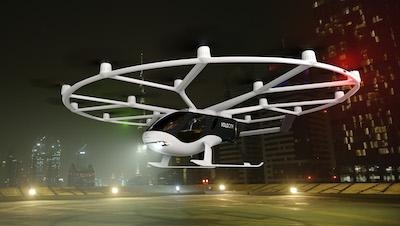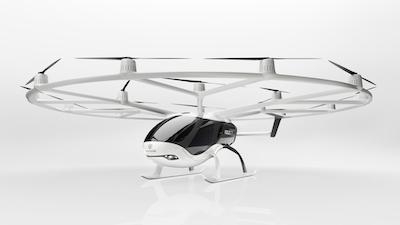Sat, Aug 24, 2019
VoloCity To Become First Commercial Volocopter Aircraft
Volocopter has presented the design for its newest air taxi model: VoloCity. This will be the fourth-generation electrical take-off and landing aircraft (eVTOL) by the German Urban Air Mobility developer. The VoloCity has been designed to meet the safety standards specified by the European Aviation Safety Agency (SC-VTOL category enhanced) and incorporates user feedback as well as test data from all previous Volocopter generations. With a calculated range of 18 nautical miles and airspeed of 60 knots, the VoloCity is designed to serve as an on-demand inner-city air taxi.

The learnings of over 1,000 test flights on previous Volocopter generations and market research with several hundred potential customers have informed the design and technical specifications of the VoloCity. The result is an aircraft with visible improvements that still stays true to the well-known Volocopter technical and safety features: 18 rotors, redundancy in all critical systems, a low noise signature and a rigid commitment to the inner-city mission.
Features include:
- Payload to accommodate 2 people including hand luggage
- Increased flight efficiency through aerodynamically shaped rotor beams, a newly introduced stabilizer to create increased stability in flight and additional lift
- Iconic design with fluid lines is a seamless continuation of architectural language of the future VoloPort all the while combining unprecedented technological achievements and user comfort
“

The VoloCity is our most powerful Volocopter yet. It is rigorously designed to meet the demands of Urban Air Mobility and incorporates all requirements of the SC-VTOL certification standard established by EASA in July 2019. It is a result of all insights we have gathered from our extensive testing programmes over the past years.” says Florian Reuter, CEO of Volocopter. “With the VoloCity we will open the first commercial routes and bring Urban Air Mobility to life.”
Volocopter wrote aviation history with the first manned flight of an electrically powered vertical take-off and landing aircraft in 2011. Since then, the German company has developed three generations of aircraft and performed public flights most notably in Dubai in 2017 and during CES in Las Vegas in 2018.
The company is now focusing on establishing the necessary ecosystem around the aircraft to bring on-demand Urban Air Mobility services to life. This entails building up the operational environment such as the physical take-off and landing infrastructure and integrating into air traffic management systems of interested cities. Volocopter is working with global players like Fraport, the operator of Frankfurt International Airport (FRA) to optimize passenger and ground procedures and align regulations with the relevant authorities.
Until the commissioning of VoloCity, Volocopter will continue to test, improve, and demonstrate their Urban Air Mobility vision with the current 2X pre-series model. A public test flight is scheduled for Q4 this year in Singapore, where Volocopter will also display the first VoloPort Urban Air Mobility infrastructure prototype together with its partner Skyports.
(Images provided with Volocopter news release)
More News
“These new aircraft strengthen our ability to respond quickly, train effectively and support communities nationwide. Textron Aviation has been a steadfast supporter in helpin>[...]
From 2011 (YouTube Edition): Rugged, Legendary, STOL Twin Makes A Comeback The de Havilland Twin Otter is an airplane with a long history, and it gained a reputation as a workhorse>[...]
A Wind Gust Lifted The Right Wing And The Airplane Turned To The Left Analysis: The pilot was departing from a 2,395-ft-long by 50-ft-wide turf runway. The pilot reported that afte>[...]
Have A Story That NEEDS To Be Featured On Aero-News? Here’s How To Submit A Story To Our Team Some of the greatest new stories ANN has ever covered have been submitted by our>[...]
Braking Action Advisories When tower controllers receive runway braking action reports which include the terms “medium," “poor," or “nil," or whenever weather con>[...]
 Aero-News: Quote of the Day (12.18.25)
Aero-News: Quote of the Day (12.18.25) Classic Aero-TV: Viking Twin Otter 400--Bringing the DHC-6 Back Into Production
Classic Aero-TV: Viking Twin Otter 400--Bringing the DHC-6 Back Into Production NTSB Final Report: Rans Employee Flying Club Rans S-6ES Coyote II
NTSB Final Report: Rans Employee Flying Club Rans S-6ES Coyote II ANN FAQ: Submit a News Story!
ANN FAQ: Submit a News Story! ANN's Daily Aero-Term (12.18.25): Braking Action Advisories
ANN's Daily Aero-Term (12.18.25): Braking Action Advisories




